- Home
- Edward Lee
Buttermilk Graffiti Page 11
Buttermilk Graffiti Read online
Page 11
Mojo Sauce | Makes about ¾ cup
¼ cup fresh orange juice
¼ cup fresh lime juice
¼ cup olive oil
1 teaspoon salt
½ teaspoon chopped fresh oregano
¼ teaspoon ground cumin
8 garlic cloves
Combine the orange juice, lime juice, olive oil, salt, oregano, cumin, and garlic in a blender and puree until smooth. This is best used right away, but you can store it, covered, in the fridge for a few days.
Chapter 6
Slaw Dogs and Pepperoni Rolls
When I found out that Ronni Lundy was embarking on a series of road trips through Appalachia for her book Victuals, I called her up and volunteered myself as a road trip companion. Lundy’s book Shuck Beans, Stack Cakes, and Honest Fried Chicken was the first cookbook I bought when I moved to Kentucky. It was the first cookbook I read cover to cover, as you would a novel. Until then, I had always thought of cookbooks as references you flipped through to find what you needed: a recipe for a clafoutis, or how much salt one used to brine a chicken. Cookbooks provided measurements and instructions, but I never thought to go to them for a sense of time and place. Though she has published more than ten books, Victuals is the one Lundy was destined to write. It is the book that no one but she could have written, and it is why I wanted to follow along while she researched it.
Ronni didn’t know me very well at the time. She agreed to let me tag along, I think, out of generosity. She would be the first one to tell you she was nervous about letting me join her. What if we didn’t like each other? Five days together in a car with someone you barely know can be a disaster. When she agreed over the phone, I hung up before she could change her mind. This is the story of our trip together.
I meet Ronni at the Asheville airport. She is a small, sprightly woman in her sixties who glows with energy. The first thing I notice when I jump into her van is an oversize Rand McNally road atlas. It is so big that she is completely hidden behind it, except for her fingers curled around the edges of the cover. Her singsong voice echoes from the driver’s seat. I start to laugh involuntarily. I ask her if she wants to use my GPS.
“Mr. Lee, are you making fun of my maps?”
“No, ma’am.” I snap back to attention.
And so begins our road trip through Appalachia.
If there ever was a yin to my yang, Ronni is it. She smiles when I pout. She is the vigor to my dullness, the intellect to my instinct. She is honey, and I am treacle. Ronni is a mountain girl from Corbin, Kentucky. She began her career in Louisville, writing about music, mostly bluegrass, and there is no lengthy conversation with Ronni that does not at some point steer toward the music of Bill Monroe. It is because of her that I listen to his music. It is because of her that I don’t put sugar in my cornbread.
Ronni’s family moved to working-class Louisville when she was a child, but she remembers vividly her father’s longing to return to the mountains. “These mountains belong to me, and I have always been drawn back to these parts.”
She insists on driving, and driving fast. I’m not sure when they stopped making the Astro van, but hers looks like it came from an early Soviet-era space program. The steering wheel is wider than her torso, but she manages to whip the van around curves with little effort. She won’t slow down before taking the curves, and the winding mountain roads bend and weave without mercy. We’re listening to Allegheny Mountain Radio. I look over at Ronni. She is smiling as she talks.
“It’s a difficult life here, but these lands speak to me. They are more sacred, more holy. The difficulty is part of the appeal. And would ya look at the view.”
The van sputters as we crest over a ridge. These steep, verdant hills carved out of prehistoric violence have had an eternity to become smooth. They roll and undulate like fairy-tale landscapes. The homes sit far apart, isolated. A church stands alone on a hill. Through a clearing, we see an abandoned covered bridge spanning a shallow stream flanked by hulking limestone rocks. It is hard not to fall in love with this land. It is hard to look at this place and not believe in God. The roads through the valleys are lined with poplar and ash trees, dense and emerald green. You can drive for miles without feeling sunlight on your cheeks. When we arrive at another vista, Ronni slows the van to a crawl so we can breathe in the view. She points to where the pasture meets the heavens. Her coral green eyes fall on me like sunlight on a dewy morning. Her short white hair hugs the curves of her temples. She starts every new sentence like the lyrics of a love song: “You are never far from death and darkness even when you are standing in the light.”
For our first stop, we find a small roadside diner that sells sandwiches and pies. Ronni talks to me about the pickles of this region, about bread and pigs and why pork became the major source of protein—cattle were not a viable industry in the steep landscape of Appalachia. She schools me on J.Q. Dickinson salt and the history of the salt mines in these parts. We talk about coal mines and carbon factories, about religion and crystal meth. The paradox of poverty nestled in an Edenesque forest of abundance is everywhere. When coal was discovered here, it altered the course of paradise. The promise of this “black diamond,” as it is called, attracted people from far and wide. Prosperity fraught with peril became the mountain way of life. These days, the mines are closing, and a more insidious practice of mountaintop removal provides plenty of coal without the need for as many workers. What remains is a complex story of community that is both distressing and uplifting. My slice of pie is $1.29.
One of the foods I’m most excited about is the West Virginia slaw dog. I have committed to memory the essay Emily Hilliard wrote for the Southern Foodways Alliance in which she recounted her travels on a quest for the famous dog. I have recorded the places she wrote about in the article, hoping to try a few, but I don’t bring that up at first. The Appalachia that Ronni is writing about is more historic and culinary. I’m embarrassed to interrupt her discussion of salt-risen bread with a request for a processed hot dog. I sheepishly ask her if we can stop off at a few places if they’re not too far out of the way.
“Well, buddy, why didn’t you say so earlier? You’re talking my language.”
My heart nearly explodes.
A West Virginia hot dog is a regional specialty that starts with a soft commercial hot dog bun. Yellow mustard is slathered on first. A boiled beef wiener is placed in the bun next. Ground beef chili without beans is added to that. The kind of chili will differ from place to place, but it is commonly a tomato-rich variety easy on the spice. On top of the chili is placed chopped cabbage slaw held together with mayo and vinegar, creamy and tart. Finally, a light smattering of finely chopped raw onion gets put on top. You can find this dog almost everywhere in the region, from roadside diners to gas stations and local bars. In Virginia, it’s called a slaw dog. In West Virginia, it’s simply a West Virginia hot dog, though in the northern parts, folks tend to serve it without the coleslaw. At the famous Umberger’s in Wytheville, Virginia, they call them Skeeter Dogs and sell them for two bucks apiece, but at most places, you can find them for two dollars for a pair. At first glance, there is nothing about this hot dog that looks special, but once you take a bite, you know you’ve touched the nirvana of hot dogs. That first bite tells you everything. The structure of the chili is critical, because if it’s too tight, it doesn’t collapse in your mouth with the other ingredients. Too loose, and the chili dog falls apart after the first bite, dissolving into a sloppy mess in your hands. The same goes for the slaw. When it’s done right, there is harmony and balance. I don’t think Ronni truly trusted me as a person until she witnessed me take down two slaw dogs with a slug of hot black coffee before 8:00 a.m.
The West Virginia hot dog is a regional celebrity. There are websites devoted to it. Though the wiener and bun are almost always factory made, there is pride in the slaw and enough technique and variation in the chili that a lively debate rages about w
ho makes it best. Skeenies or King Tut? Skeeter’s or Buddy B’s? No one knows the precise origin of this dog. Ronni traces it back to the chili buns served in the pool halls that littered the railroad towns of the region. Another plausible story tells of the struggling immigrant families, many of whom grew vegetables in their backyards to supplement their humble diets. Cabbage was easy to grow, so families started to make slaw—lots of it. The slaw found its way into many dishes, including the hot dog. The first place to sell the slaw dog was the Stopette Drive-In in the 1920s, but many argue that home cooks in the region started eating their hot dogs with slaw well before that. One thing is for sure: the slaw dog is a celebration and a source of pride.
The slaw dog stands in stark contrast to West Virginia’s other regional specialty: the pepperoni roll. A humble food of Italian origin, it was invented by immigrant Italian coal miners who needed a hearty snack that was both portable and easy to eat. D’Annunzio’s, a landmark bakery in Clarksburg, has been making it for decades. The preparation couldn’t be simpler: pepperoni cut into sticks about four inches long and baked into a soft, sweet roll. Nothing else: just dough and pepperoni baked together.
I arrive at D’Annunzio’s at 8:00 a.m., when the rolls are just coming out of the oven. I stand in a line of polite locals, many of whom are buying the rolls by the dozen. I take a bite of mine. The dough is soft and forgiving, the pepperoni lukewarm. All I taste is powdered paprika, dry and unbalanced. It takes a few chews to loosen the fat from the sausage and for flavors to develop in my mouth, but even then, it is bland and monotonous. I am underwhelmed, to say the least.
Ronni tells me that the pepperoni roll is the food of the working class. It is about making connections. When your entire day is spent deep in a coal mine, that little bit of pepperoni may be all that connects you to the sanity of family and your identity and life aboveground.
I buy a dozen rolls and decide to carry them with me for the next few days.
Clarksburg, once a thriving city, is now grappling with a rise in poverty and a decline in population. The downtown is nearly empty. As we drive through the outskirts of town, near the factories, we see abandoned houses in foreclosure and trailer homes in varying states of decline. The only bright lights come from the legal gambling stores, called hot spots. Some are also bars, but mostly they are small spaces, dimly lit and sparsely furnished, with about five or six video slot machines lined up against a wall. The patrons in the hot spots are old. They smoke while spinning the slots, beers snugly protected in plastic cup holders attached to their seats. At one of these places, I meet Alba, the manager. She tells me she is Italian in a West Virginia drawl so thick I can taste the molasses. I order a root beer, and she teaches me how to play Keno. She tells me that most of the people who used to live here have moved to Bridgeport. She tells me to go to Minard’s for a good Italian meal. You can get fried chicken and spaghetti there.
Alba’s family came generations ago, to work in the factories, and never left. There are a lot of Italians here, she tells me. I tell her I think it’s funny that, after so many generations, she would still call herself Italian and not West Virginian. Well, she says, we’re all rednecks first.
I give her a pepperoni roll, and she thanks me. D’Annunzio’s is the best, she confirms. Then the door buzzer rings, and she lets in an older lady who is alone. They know each other. Alba tells me she has to go make some money and leaves me alone to my gambling.
The old lady isn’t interested in talking to me, just playing the slots. She takes a seat at the machine farthest from me. The reflection of the spinning slots bounces off the glasses on her shriveled face. She looks like she might be of Italian heritage as well. Alba whispers to me that the old woman doesn’t socialize much but that she used to bake pepperoni rolls and they were the best. She’d sell them from her home, but she is too old to do it anymore. I watch this old lady’s hands as she works the touch-screen slots, and I see they are still nimble. I want to learn from her hands, not how to win at slots but how to work the dough for a pepperoni roll.
As modern cooks, we are spoiled. We can take a recipe out of its native environment without the tedium of having to find a person who will teach us. We have removed the culture from the foods we consume and replicate. For most of human history, it has been quite the opposite. I’m sure that for many grandmothers, the idea of learning how to cook from a book was as foreign to them as it is for us to learn a recipe without a book, with nothing more than a matriarch at our side showing us how to knead a fistful of dough.
I offer the old lady a pepperoni roll, but she refuses. She moves her purse to the other side of her chair, away from me. I eat the pepperoni roll myself. They are starting to grow on me. It is dark in the room, save for the digital luminescence of the video slots.
So many of my assumptions about food come from a desire to tell a neatly packaged story, one that has a happy ending of climactic flavors and rewarded chefs. But that tidy story is rarely the case. Along my journey, through Appalachia or any of the small towns I’ve traveled to in the writing of this book, the most insightful moments have been quiet and unseasoned. This has made me question myself and my expectations. I’m owed nothing by the people and the culture of this place. I have neither the right to judge nor the history to comment on them. If the pepperoni roll seems bland to me, it is a fault in my own palate, which is unable to detect the value of its plainness. I chew another bite and try to think of someone who has been working at a physically grueling job since dawn. This pepperoni roll is the one pleasure he may have been looking forward to all morning long. This pepperoni roll may be all he has to eat until he sits down to supper late in the evening. Slowly, I get it. The darkness of the room is suffocating, and I’ve been here only twenty minutes. The pepperoni roll suddenly tastes like the best thing I’ve ever eaten. I leave ten dollars’ worth of credits in the slot machine and head out the door.
The road from Clarksburg to Staunton is about as scenic a drive as you’ll ever experience. Tiny towns such as Elkin appear out of nowhere, like apparitions. There are a lot of abandoned homes and buildings along the way. Many people have left.
“What makes the others stay?” I ask Ronni.
“There is the solitude, the independence. Some folks need it. It calls to them. The mountains provide that, if nothing else, sometimes.”
Staunton is a quaint town that draws tourists from the Shenandoah Valley. Here, you don’t see the economic struggles that plague most of the region. It is a place where a chef such as Ian Boden can cook a forward-thinking, Southern-inflected tasting menu. His kitchen is the size of a broom closet, but he has had glowing articles written about him in Esquire. His place is closed today, so Ronni and I visit an old diner called the Beverly, where the menu is handwritten on the wall and the daily pies are displayed on a wooden table against a chest of vintage plates. We linger over mediocre coffee and fabulous pie.
One of the trends of modern restaurant culture that disturbs me is the obsessive need for all facets of a meal to be perfect. Not so at the Beverly, where they focus on pies. My chess pie is delicious. There is a layer of slightly cracked sugar on top and sweet custard in the middle over a bottom crust that is thicker than most but that still politely surrenders to a push from my fork. Ronni’s coconut meringue pie is tall and proud, the meringue is sweet and airy but taut at the same time and perfectly toasted on top. The Beverly’s silverware is plain, and the tablecloths need to be replaced, but there is a quiet confidence here. The food is good; the desserts are even better. The coffee may be bitter and watery, but the owners of the Beverly are okay with that. The place is run by two aging sisters who don’t have time for suggestions. They don’t have a craven need for praise, either. I like places like these, places that aren’t perfect. At the end of the day, the flaws make the Beverly seem more human. The sisters seem to deflect criticism. It isn’t that they don’t care about the restaurant; they simply don’t feel the need
to please everyone. (Sadly, they are also outdated. The Beverly shut down soon after my visit.)
The two sisters who run the Beverly are a part of the rural Appalachia that Ronni champions. They may be set in their ways, but they come from a poor working-class culture that embodies a fighting spirit. The sisters are simple folk, as people around here say, but they are not a part of the stereotypical portrayal of toothless, Mountain Dew–drinking hillbillies that angers people like Ronni. I’m here with her partly because I want to see beyond the stereotypes, but I need a guide to help me. It is too easy to look at the sisters of the Beverly, with their missing teeth, and think, Oh, what a duo of wonderfully authentic hillbillies! There is more to the story than that, though.
I ask Ronni, in earnest, “Who are the people of Appalachia?” Are they the idyllic, fiddle-playing, dungaree-wearing, happy tribe of mountain folks untouched by time and corruption? Are they the poor immigrants who have fought tooth and nail to carve out a small piece of America for themselves in this unforgiving land? Are they a misunderstood people whose desire for isolation has been interpreted as an insular culture formed out of racism? Maybe somewhere in the middle of all the above lies the truth.
Ronni talks to me about immigrant families, about the migration that populated these lands. This is not an impoverished place of desolation. It is full of historical paths, some painful and some angelic. She tells me that the early migrants here were hardworking, mostly white Englishmen, Scots, Italians, and Germans—mostly honest, all scrappy. When immigrants to America were making their way westward, most passed through the Appalachian region without stopping, preferring to settle instead on the flatter, farmable terrains of Ohio, Indiana, and Illinois. It takes a stubborn, thick-skinned person to decide to settle here.
I think about my wife’s ancestry. She is a Dürholtz. They come from the Black Forest region of Germany. I imagine they must have crossed through these mountains at one point along their westward journey. They have been in Indiana more than six generations. They are meek, they go to church, and they keep to themselves. Gossiping is the worst of their sins. I see nothing of them in the feisty people I meet here in Appalachia, be they from Germany, Ireland, or Scotland. The people of the mountains are cut from a different cloth.

 In the Year of Our Lord 2202
In the Year of Our Lord 2202 The Minotauress
The Minotauress Terra Insanus
Terra Insanus The Stickmen
The Stickmen Flesh Gothic by Edward Lee
Flesh Gothic by Edward Lee Family Tradition
Family Tradition You Are My Everything
You Are My Everything The Backwoods
The Backwoods The Teratologist
The Teratologist Smoke and Pickles
Smoke and Pickles Buttermilk Graffiti
Buttermilk Graffiti Dahmer's Not Dead
Dahmer's Not Dead Quest for Sex, Truth & Reality
Quest for Sex, Truth & Reality The Innswich Horror
The Innswich Horror Brides Of The Impaler
Brides Of The Impaler Goon
Goon Trolley No. 1852
Trolley No. 1852 Sacrifice
Sacrifice Monster Lake
Monster Lake Succubi
Succubi Lucifer's Lottery
Lucifer's Lottery Monstrosity
Monstrosity The House
The House The Dunwich Romance
The Dunwich Romance Operator B
Operator B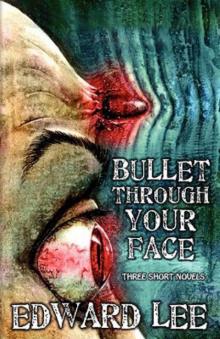 Bullet Through Your Face (improved format)
Bullet Through Your Face (improved format) Grimoire Diabolique
Grimoire Diabolique Room 415
Room 415 The Messenger (2011 reformat)
The Messenger (2011 reformat) Incubi
Incubi The Black Train
The Black Train House Infernal by Edward Lee
House Infernal by Edward Lee City Infernal
City Infernal Creekers
Creekers The Haunter Of The Threshold
The Haunter Of The Threshold Mangled Meat
Mangled Meat The Doll House
The Doll House Header 2
Header 2 Bullet Through Your Face (reformatted)
Bullet Through Your Face (reformatted) Header 3
Header 3 Infernal Angel
Infernal Angel Pages Torn From a Travel Journal
Pages Torn From a Travel Journal Edward Lee: Selected Stories
Edward Lee: Selected Stories The Bighead
The Bighead The Chosen
The Chosen